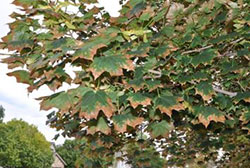Leaf scorch is quite prevalent after a hot, dry summer. Symptoms include browned leaf tissue between veins, at leaf tips or along leaf edges. In severe cases, the entire leaf may become brown and dry. On evergreens, needles brown at the end but may remain green at the point of attachment. 
Leaf scorch is caused by a net water loss that occurs when leaf transpiration exceeds water uptake by roots.
Any environmental or cultural factor that decreases available moisture in the root zone, decreases water uptake by roots, or increases leaf transpiration can result in scorch. Some of these factors include: high light intensity, low humidity, high temperatures, drying winds, root rots, drought, limited rooting area and high soil salts. All of these factors are common in Colorado summers, making scorch a prevalent issue.
Tree species subject to leaf scorch include linden, maple, cottonwood, aspen, pine and spruce.
Leaf scorch cannot be reversed. Try to determine the cause. Avoid further scorch by supplying adequate moisture. Mulch may help to prevent or reduce leaf scorch. If the cause is reversed in subsequent years new leaves will not exhibit symptoms of scorch.
For more detail, see the CSU Extension fact sheets on leaf scorch and tree roots



